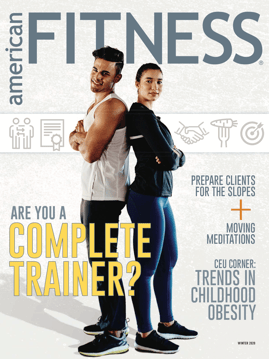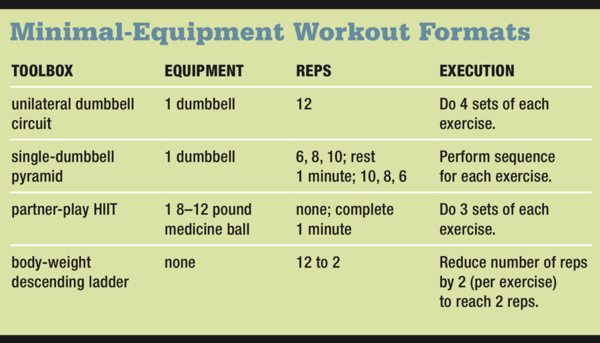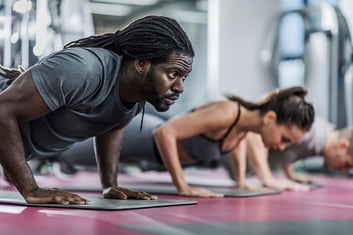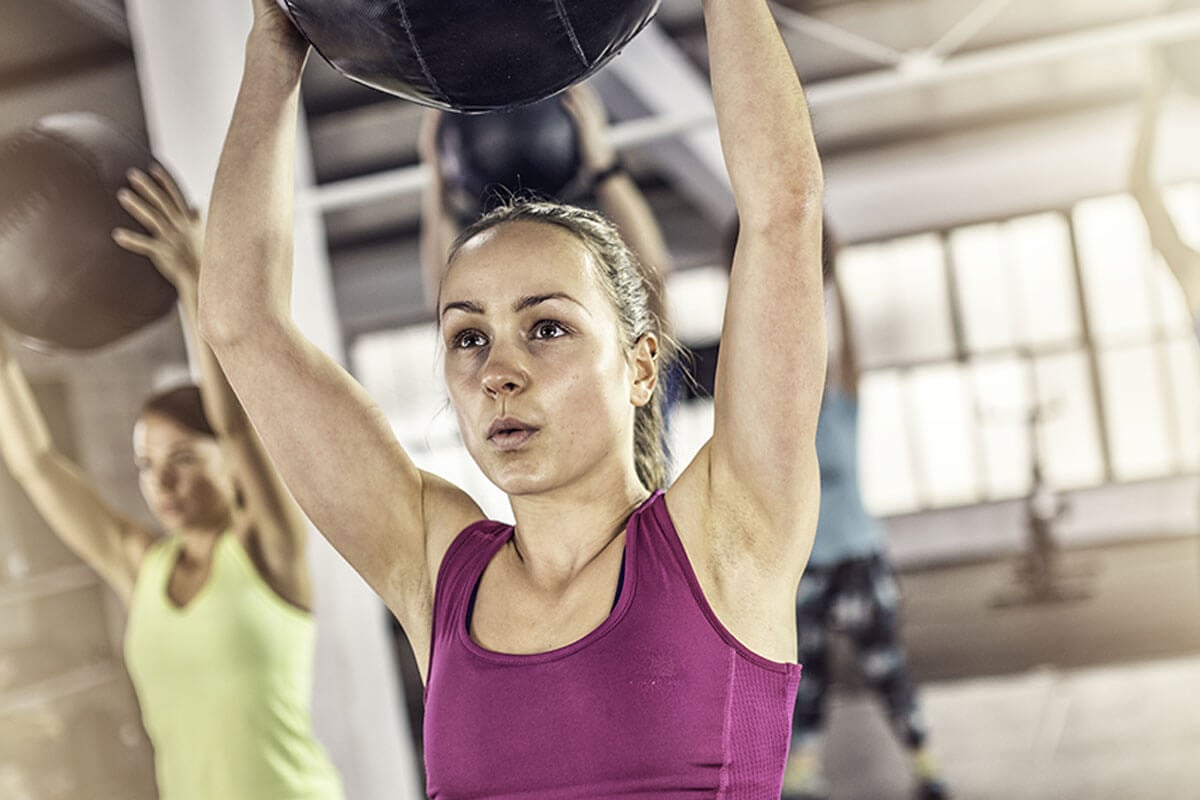Originally published in the Winter 2020 issue of American Fitness Magazine.
Being a good group exercise instructor (and hybrid trainer) means being a master of improvisation. The ability to adjust class plans on the spot is a necessary skill to ensure that all participants have a safe and effective workout. That’s true of equipment, too.

Perhaps you don’t have enough weights to accommodate a large post-holiday crowd, or maybe you have a group of newcomers who are not ready to use more advanced
equipment. If these scenarios are familiar, having a toolbox of exercises that use minimal equipment will enable you to provide an awesome workout experience every time, regardless of class numbers or the ability level of your group.
Instructing with less equipment is simple, and the creative possibilities are endless! You can train endurance, strength, balance—and everything in between. Here are some suggestions to get you started. Use minimal-equipment exercises in a standalone circuit or mix and match them to build your class, depending on workout goals and time available.

SINGLE-DUMBBELL EXERCISES
If you don’t have enough dumbbells to accommodate your group, no problem. Using one dumbbell instead of a pair is a great alternative, especially if participants are asking for more core work. When training with a single dumbbell, you can load one side of the body while executing traditional strength exercises. The uneven distribution of resistance requires more core activation to maintain proper alignment, and attendees will benefit from this challenging and functional approach to improving strength and muscular endurance.
Pam Benchley, continuing education provider for BOSU®, the Surge® and Stages Cycling, is innovative in her use of single-dumbbell exercises with clients. “I use them to replicate functional movement patterns of daily living, like putting something up in a cupboard or picking something up off the floor. I love utilizing unilateral pressing and rotational moves. Many of our daily movements are not symmetrical, so this is how we should train.”
UNILATERAL DUMBBELL CIRCUIT
Equipment: one dumbbell per person
Format: Perform each exercise for 12 reps on each side, cycling through the sequence 4 times.
SUITCASE SQUAT
Hold dumbbell in one hand, standing with feet slightly wider than shoulder-width apart. Lower into deep squat; place dumbbell on floor. Return to standing. On next rep, pick up dumbbell. Maintain erect posture and avoid leaning to one side.
SINGLE-ARM CHEST FLY
Begin in supine position on bench or step, holding dumbbell in one hand directly over shoulder. Lower arm toward floor, with slight bend in elbow, until dumbbell is in line with chest, then raise it back to starting position. For more challenge, lift feet off floor.
ONE-ARM DEADLIFT
Stand with feet hip-width apart, holding dumbbell in one hand. Hinge from hips and lower to 90-degree angle while reaching dumbbell toward floor. Return to starting position. Maintain neutral spine and avoid rotating.
UNILATERAL QUADRUPED ROW
Begin in prone quadruped position with dumbbell in one hand. Perform row by reaching elbow toward ceiling. Return to starting position. For more intensity, lift opposite leg until thigh is parallel to floor.
Option: Load bilateral exercises by holding one dumbbell end-to-end. A single dumbbell offers less resistance, but it is possible to adequately overload the muscles by manipulating additional variables. Simply reduce speed of movement or increase range of motion (ROM) to provide more time under tension.
Keep in mind that resistance is only one factor affecting intensity. Think outside the box, and your participants will be sure to achieve the results they desire!
SINGLE-DUMBBELL PYRAMID
Equipment: one dumbbell per person
Format: Perform each exercise for 6 repetitions; repeat the sequence for 8 reps, then 10 reps. Rest for 1 minute, then reverse the sequence for 10, 8 and 6 reps.
REAR DEFICIT LUNGE
Stand on step with feet hip-width apart, holding dumbbell at chest end-to-end. Step back with one leg, lower into lunge position, bringing rear knee to floor. Return to standing position. Alternate lead leg. To progress, reduce speed of movement.
ECCENTRIC-LOAD SQUAT
Stand with feet hip-width apart, holding dumbbell at chest end-to-end. Lower into squat position for 3 counts. Return to standing for 1 count. Increase ROM to progress.
V-SIT CHOP
Begin seated; lean back slightly with extended spine, holding single dumbbell overhead in left hand. Lower dumbbell toward right hip while rotating spine, keeping arms straight. Return to starting position and repeat left. Increase speed of movement for more challenge.
PARTNER EXERCISES
Most of our devoted participants joined our classes because they enjoy the social atmosphere of the group exercise studio. Training alongside like-minded fitness enthusiasts offers a sense of camaraderie and allows attendees to feed off the energy of the group. Partner exercises can take this to the next level by providing even more opportunity for participants to interact, since they share one piece of equipment and work as a team to execute the exercises.
If you lead a high-intensity interval training format, partner training is ideal. HIIT involves alternating periods of high-intensity exercise with rest. Since recovery time is an integral component of this format, participants can take turns using the equipment. Select a series of exercises and use a one-to-one work-to-rest ratio; one person executes an exercise while the partner rests.
Jen Burke, a veteran instructor and continuing education provider from Rochester, New York, utilizes this approach in her small-group training sessions. “Participation in these sessions is consistent, so my clients have developed relationships. When paired up, they tend to work harder, and they also are encouraged by one another. There is a sense of accountability, as well as a lot of fun, laughter and trust being built. Participants can take on the role of coach and student, which really enhances motivation.”
PARTNER-PLAY HIIT
Equipment: one 8- to 12-pound medicine ball per pair
Format: Perform each exercise for 1 minute. Partner A works while partner B rests; then they switch. Cycle through each exercise 3 times.
BURPEE
Begin standing, holding medicine ball at chest. Squat and bring ball to floor. Jump back to plank position, continuing to hold ball, core engaged. Jump forward to wide-squat position; jump, reaching ball overhead. Add triceps pushup to progress.
Check out this burpee demonstration on the NASM Exercise Library page.
MEDICINE BALL SLAM
Stand while holding medicine ball at chest. Raise ball overhead, then slam ball to floor while bending at knees and hips. Return to standing, reaching ball overhead. Repeat. Use heavier medicine ball for more intensity.
SQUAT CHOP
Stand with feet hip-width apart, two hands holding ball overhead. Bend at knees and hips, lowering into squat while rotating spine and pulling ball down toward left knee. Stand and reach ball overhead. Repeat on other side. Increase speed or ROM for more challenge.
BODY-WEIGHT EXERCISES
The most convenient piece of equipment in the training toolbox is body weight. Cindy Frary, director of specialty programming at Aspen Athletic Club in Syracuse, New York, often incorporates body-weight exercises into her fitness classes. “I find they provide benchmarks for progression and often lead to inspirational aha! moments. An exercise that began as a struggle for a participant will often result in a feeling of accomplishment when they can, for example, execute a more advanced plank variation or conquer a set of full-body pushups for the first time. These moments fuel commitment and keep participants inspired and reaching for more.”

Benchley also believes in the benefit of body-weight exercises. “This approach allows us to focus on how we are designed to move. Even with no resistance equipment, we can use our own body weight to shift, lift and even hold still. Pushing and pulling movements, as well as core engagement exercises, are also important.”
Include exercises that require the coordination of large muscle groups, add balance challenges, and work in multiple planes of motion. You have all the ingredients needed to offer participants a high-intensity cardio challenge.
BODY-WEIGHT DESCENDING LADDER
Equipment: none
Format: Perform each exercise for 12 repetitions. Repeat the sequence, reducing the number of reps by 2 each set, finishing with 2 repetitions.
LATERAL LEAP AND HOP
Begin standing on one leg, with slight flexion at knee and hip. Leap to one side, landing on opposite foot. Pause, then jump horizontally, landing on same foot. Repeat on other side. To increase intensity, add speed or ROM.
PRONE JACK/PUSHUP
Start in plank position with hands shoulder-width apart and feet together. Hop feet apart and back in. Then perform pushup by bending elbows and bringing chest toward floor. Press up to starting position. Maintain straight line from heels to head for both movements. For added challenge, do pushup while jumping feet apart; press back up when bringing feet together.
SQUAT JUMP
From standing position, feet about hip-width apart, squat by flexing at knees and hips until thighs are parallel to ground. Jump up and return to standing position. Increase ROM to progress.
LESS EQUIPMENT EQUALS MORE VARIETY
Less equipment does not need to be a barrier to leading your best sessions. Your participants will appreciate the variety as well as the option to train in a new way. Try the suggested workouts or apply the concepts to your favorite moves. Whether working with partners, utilizing body weight for resistance or experimenting with unilateral movements, you can deliver a dynamic and unique workout every time.












